July 17th 2019 11:56 am | by Svetlana Pantelic | Posted in Blog
Discovered 2,000 years ago in India, the bold and beautiful ruby is considered the King of Gems. Signifying wealth, success, romance, health, and devotion, the gorgeous stone was utilized by ancient warriors on the battlefield, as well as royal figures throughout the world’s history.
In the first century AD, the Roman scholar Pliny included rubies in his Natural History, describing their hardness and density.
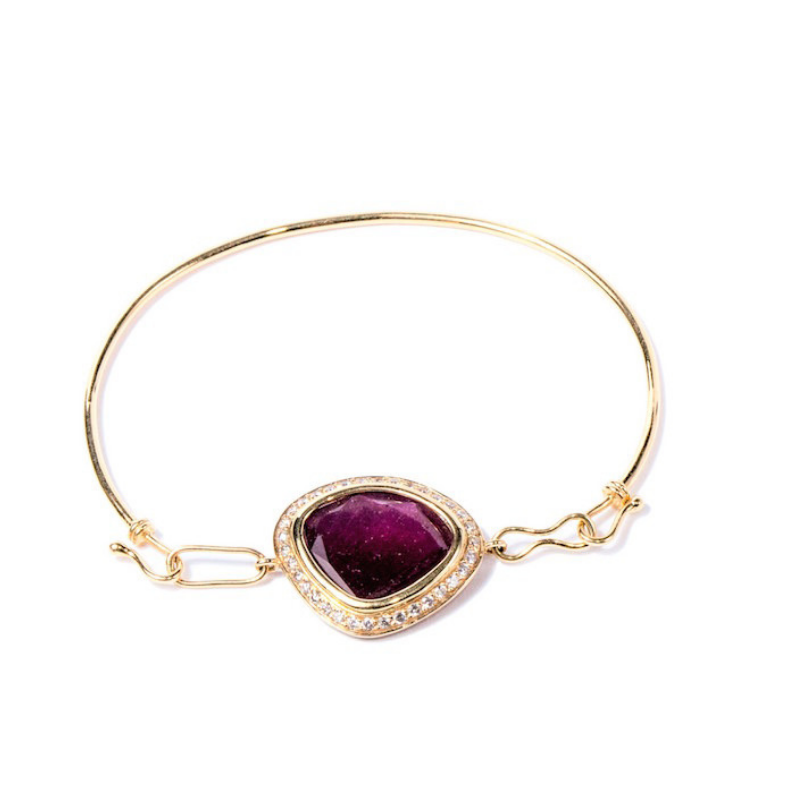
Gemme Couture Red Velvet Ruby Diamond Bangle Bracelet
Deriving from the Mogok region of Myanmar, formerly known as Burma, rubies have stayed at the top of the gem-chain for years. The radiant stone, identical to sapphires in every way apart from color, are the scarcest of all gemstones.
Ancient warriors used to set rubies into their flesh, believing that the stone would bring them protection and power in battle. The Imperial State Crown, made for the coronation of King George VI in 1937, contains The Black Prince Ruby, a stone that is considered to be one of the most fascinating gems in existence. Medieval Europeans believed that by wearing rubies, they were guaranteed wealth, wisdom, and success. Queen Elizabeth began wearing the Burmese Ruby Tiara in 1973, in which 96 rubies were set into her custom tiara after receiving them as a wedding gift from the Burmese people.
For as long as history has been documented, there has been an affinity for the ruby, a stone that has been called the most precious of the 12 stones created by God.
Red is the color of our most intense emotions – love and anger, passion and fury. It’s associated with objects of power and desire – like fast cars and red roses. Early cultures treasured rubies for their similarity to the redness of the blood that flowed through their veins and believed that rubies held the power of life.
In the ancient language of Sanskrit, ruby is called ratnaraj, or “king of precious stones.”
Ruby is one of the most historically significant colored stones. In the history of rubies, one of the things that most often stands out is that Rubies are mentioned four times in the Bible, in association with attributes like beauty and wisdom.
The ruby was one of the stones in the high priest’s breastplate (Exodus 28:17). A comparison is made between the value of wisdom and rubies (Job 28:18; Proverbs 3:15; 8:11). The price of a virtuous woman is said to be “far above rubies” (Proverbs 31:10). The exact meaning of the Hebrew word is uncertain. Some render it “red coral;” others, “pearl” or “mother-of-pearl.”
Anciently, it was thought that rubies, like diamonds, were created by a bolt of lightning. A popular belief was that this gemstone actually generated light from within itself.
Ancient Hindus believed that those who offered beautiful rubies to the god Krishna were granted rebirth as emperors.
Hindus divided ruby into four castes, calling the authentic Oriental ruby a Brahmin.
Someone in possession of a Brahmin was believed to have the advantage of ideal safety.
Ruby has accumulated a host of legends over the centuries. People in India believed that rubies enabled their owners to live in peace with their enemies. In Burma (a ruby source since at least 600 AD—now called Myanmar), warriors possessed rubies to make them invincible in battle. However, it wasn’t enough to just wear the rubies. They had to insert them into their flesh and make them part of their bodies.
The name ruby comes from the Latin word ruber, which means “red.” The glowing red of ruby suggested an inextinguishable flame burning in the stone, even shining through clothing and able to boil water.
Ruby retained its importance with the birth of the western world and became one of the most sought-after gems of European royalty and the upper classes. Many medieval Europeans wore rubies to guarantee health, wealth, wisdom, and success in love.
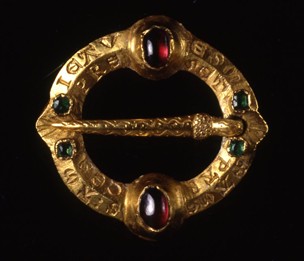
Late Medieval Ring brooch 14th century from the British Museum. Gold; set with two rubies and four emeralds end cabochon. The meaning of the inscription is difficult to determine, but the sentiment is most likely to be one of love or friendship.
Royal houses and the elite celebrate the ruby by adding it to their exceptional jewelry collections as many believe the precious stones guarantee health, wealth, wisdom, and success in love.
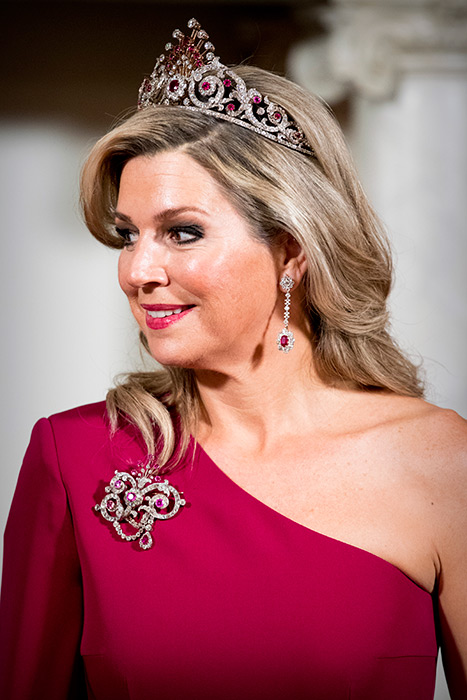
The Dutch Queen Maxima wears diamond and ruby oversize brooch, elegant drop earrings, and a spectacular tiara.
Truly fantastic rubies larger than 2.0 carats are very rare. Those found are usually from the Far East.
The highest quality rubies come from the Mogok mines in the North of Myanmar (formerly Burma).
Once the main source of the most beautiful and huge “Pigeon’s Blood” rubies, the mines are almost exhausted. These rare Mogok rubies are left untreated and are extremely valuable.
The fifteenth and sixteenth centuries were the Age of Exploration. The first European traders to Burma (about 1400 CE) were interested in spices, which were literally worth, which literally worth their weight in gold. However, when reports of rubies started filtering from travellers, interest shifted to jewels.
While the royal jewels of Burmese kings were famous throughout Asia, it is really impossible to know very much about the value of the Burmese royal ruby.
The first European who actually visit the mines in the Mogok area and to write about them Was the Portuguese Jesuit Missionary Fr. Giuseppe D’ Amanto who lived in the area from 1784.
The British were well aware of the presence of rubies Burmese holy places. It is the main reason why more than 1000 pagodas were destroyed by British troops at the end of the Third Anglo-Burmese War.
Where there are riches, there will be wars. The Anglo-Burmese Wars began in 1824 when the British first landed in Rangoon. There were three of them altogether. That was the time of Queen Victoria.
After the wars in 1886, Britain formally annexed upper Burma. It was during this period that most of the museum-quality rubies of the world were acquired.
After the development of synthetic ruby in 1908, the natural ruby market became extremely volatile, and the price of natural rubies swung wildly.
Gemology is the science dealing with natural and artificial gemstone materials. It is considered a geoscience and a branch of mineralogy.
In gemology, only four gems qualify for the elite category of “Precious Gems.” These are; diamonds, sapphires, emeralds, and the rubies.
Differentiating the ruby from spinel is what gave birth to the science of gemology. Prior to 1783, spinels and rubies were categorized as the same stone, and confusion between the two gems continued until the 1850s as both spinels and rubies tended to be found in the same few geographical areas. Now we know that some of the world’s most famous “rubies” are actually spinels.
The International Colored Gemstone Association (ICA) called spinel “the great impostor of gemstone history.” That’s because some of the most famous “rubies” in crown jewels around the world are actually spinels.

The 361-carat Timur Ruby, which was presented by the East India Company to Queen Victoria as a gift in 1851, and is engraved with the names of some of the Mughal emperors who previously owned it, was later identified as a spinel.
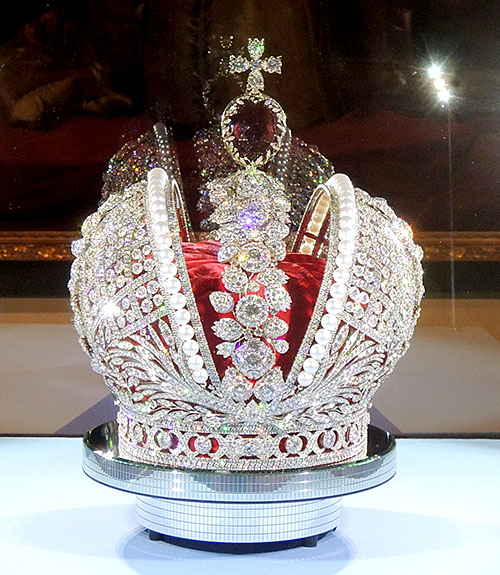
The 398-carat ruby-red gem that tops the Imperial Crown of Russia commissioned by Catherine the Great in 1763 turned out to be, you guessed it, a spinel.
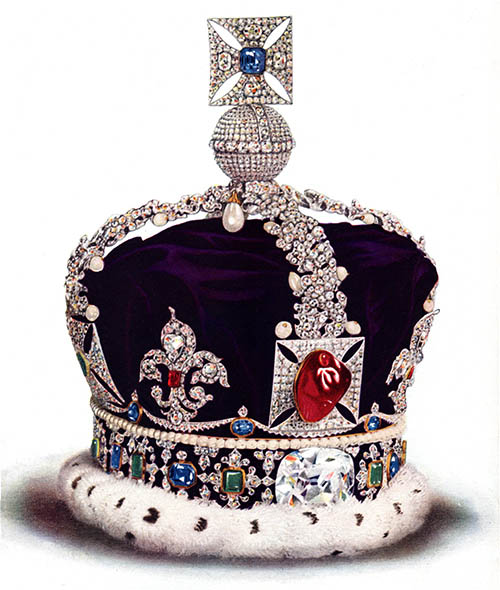
Prominently displayed on the Imperial State Crown of England is the 170-carat Black Prince Ruby, which is actually an uncut spinel.
“There’s no place like home.”, whispered Dorothy, as she clicked her ruby slippers three times and was magically whisked away to the comfort of her Kansas farmhouse. The ruby slippers are the magic pair of shoes worn by Dorothy Gale as played by Judy Garland in the 1939 MGM musical movie The Wizard of Oz. Because of their iconic stature, the ruby slippers are among the most valuable items of film memorabilia.
Many pairs were made for the film, though the exact number is unknown.
Five pairs are known to have survived; one pair was stolen from a museum in 2005 and recovered in 2018.
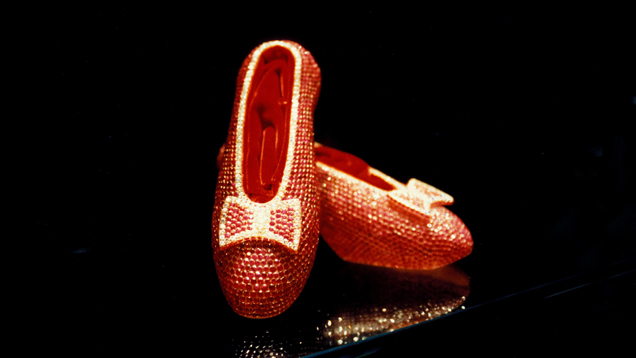
To commemorate the 50th anniversary of The Wizard of Oz, Harry Winston created real ruby slippers set with 4,600 rubies.
In the summer of 1957, the star of “Cleopatra”, Elizabeth Taylor, received a gift from her love, Mike Todd who was a director and producer. And the gift is none other than a Cartier ruby and diamond bib necklace with a matching pair of earrings and bracelet. In Taylor’s exact words – this jewelry was glorious, “rippling red on blue like a painting. I shrieked with joy, put my arms around Mike’s neck, and pulled him into the pool after me. It was a perfect summer day and a day of perfect love.”
Today, the timeless gem is making a comeback throughout lifestyle and fashion trends. Celebrities have been spotted wearing rubies on the red carpet.
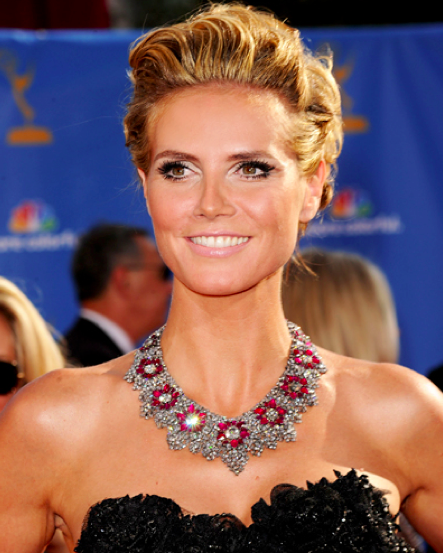
Heidi Klum, Project Runway host, who is known for her bold jewelry choices, walked the red carpet in a lavishing 3-million-dollar diamond and ruby necklace.

At the Oscars 2019, Allison Janney wore Chopard jewels, including a necklace featuring 59.03-carats of heart-shaped rubies and 67.97-carat of diamonds set in 18k white gold from the Red-Carpet Collection.
The desire for ruby is powerful today as always. As a symbol of passion, ruby makes an ideal romantic gift. Consumers are drawn to the lush color because it also signifies wealth and success.
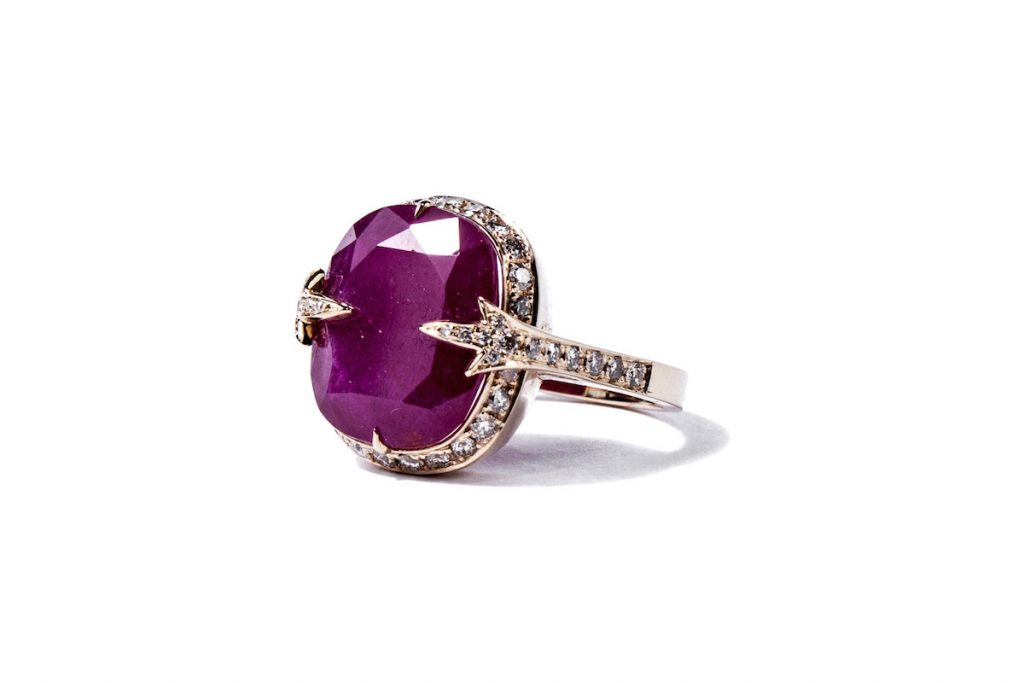
Gemme Couture Natural Cushion Cut Ruby Diamond Ring from the Rings of Desire Collection
Gemme Couture loves Rubies and value all of their color ranges, as they are all so pretty.
If you are looking for a gift for someone you love or for yourself, we have some impressive ruby jewelry pieces in our collections.